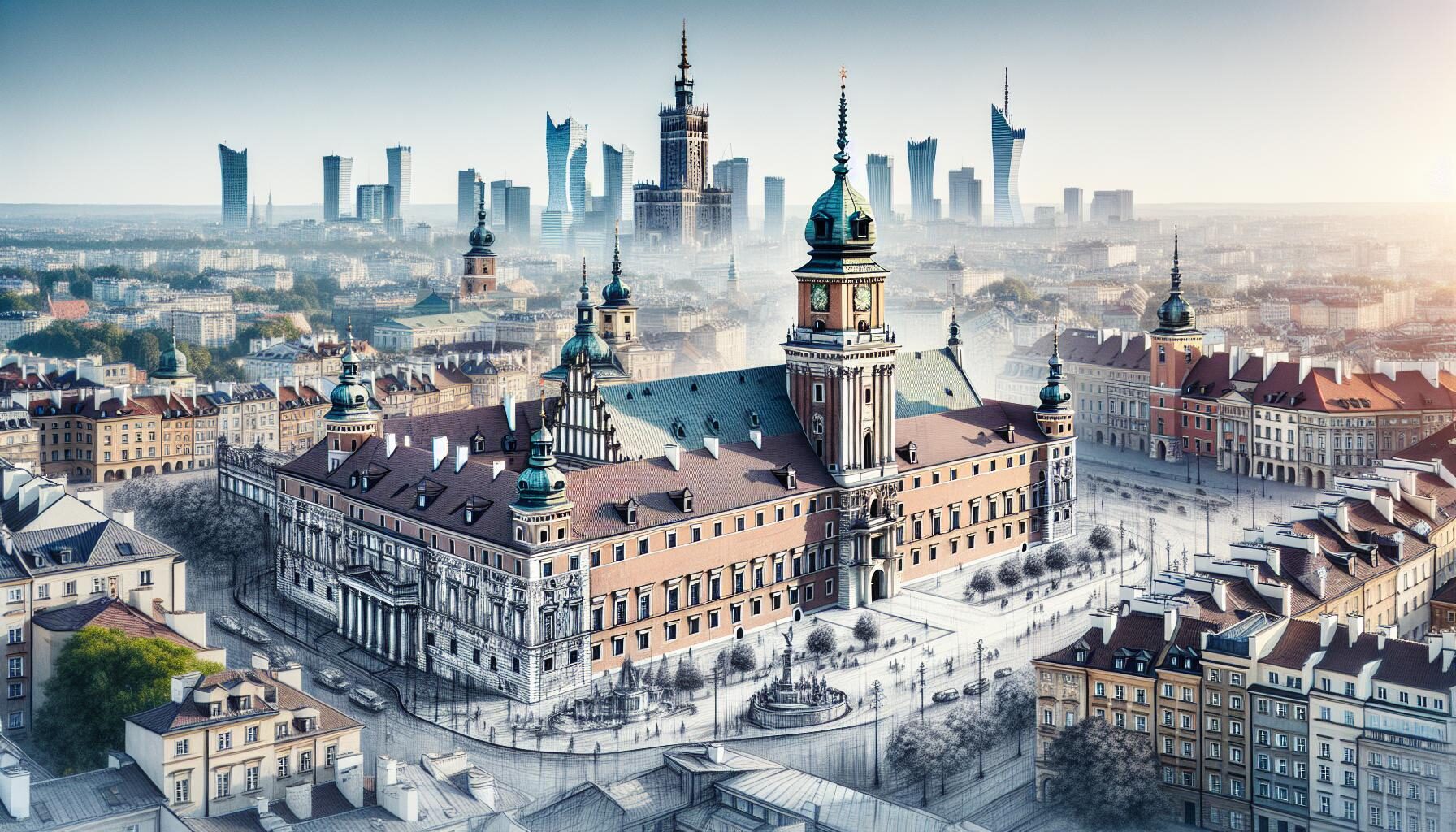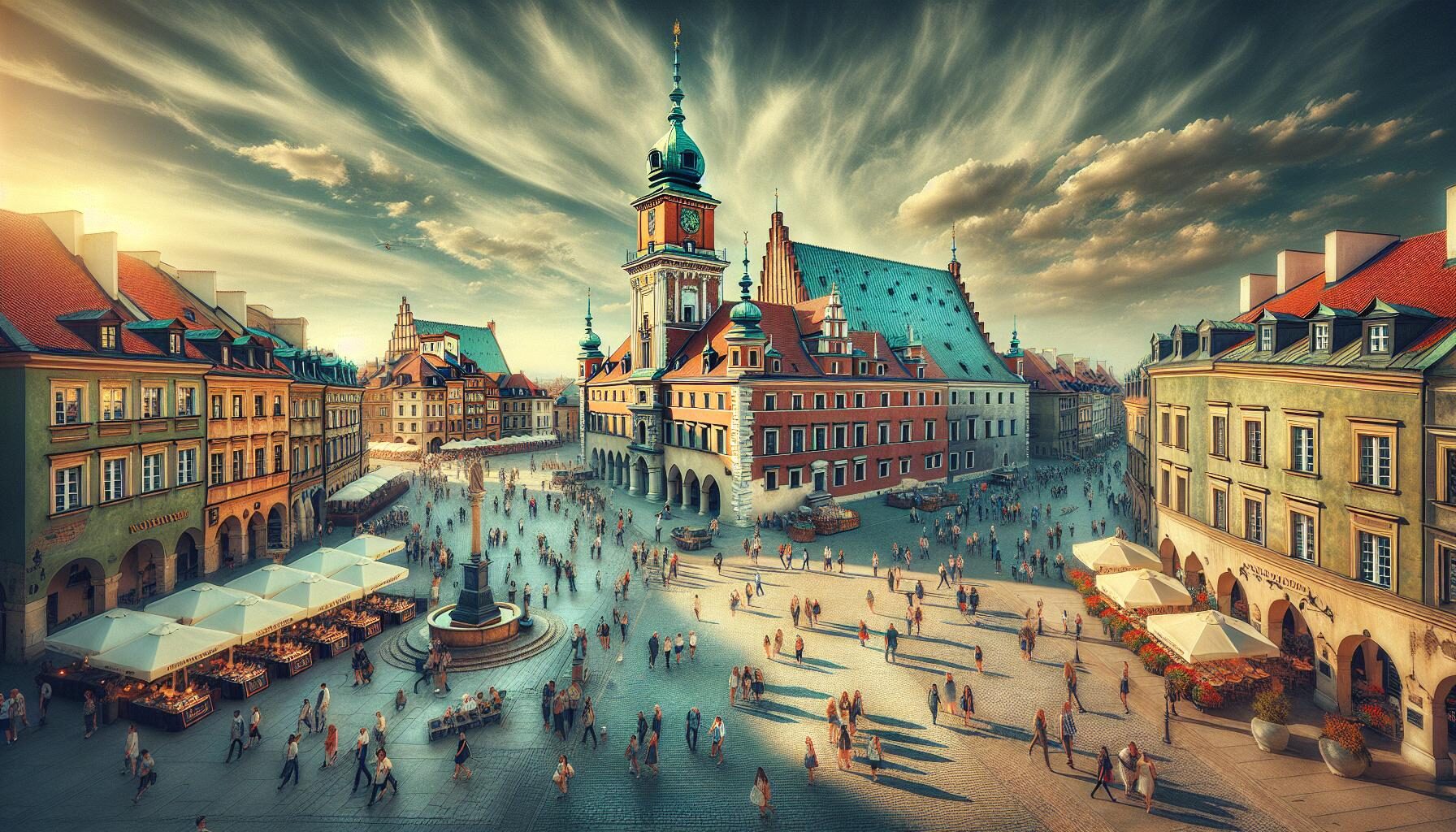Exploring Castle Square: The Vibrant Blend of History and Modernity in Warsaw’s Heart
Nestled in the heart of Warsaw, we find Castle Square, the historical epicenter of Śródmieście. It’s not just a place, it’s a vibrant testament to Poland’s rich past, a living, breathing chronicle that’s witnessed centuries of change.
This iconic square, with its colorful facades and grand monuments, has seen it all. From royal processions to political protests, it’s been the backdrop to some of Warsaw’s most significant events. Join us as we delve into the captivating history of Castle Square – the pulse of Śródmieście.
As we journey through time, we’ll uncover the stories etched into the cobblestones of this remarkable square. It’s more than a destination, it’s an experience that blends the past with the present in a fascinating dance. So, let’s step into the pages of history and explore Castle Square together.
The Origins of Castle Square
Rewind back to the 14th century, Castle Square wasn’t what we know it to be today. It started humbly, with only the Royal Castle at its epicenter. The castle, constructed under the reign of Sigismund II Augustus, was deemed the heart of the city, where Poland’s nobility resided and the nation’s decisions were made.
In the following centuries, Castle Square evolved gradually. The square expanded, with more buildings taking shape around the Royal Castle. Buzzing with different activities, it began to arc beyond its original core function. Its role as the historical, political, and social center was growing significantly. By the 18th century, Castle Square had transformed into an indispensable part of Śródmieście.
A key milestone in its development was the construction of Branicki Palace, which added an architectural gem to its premises. This aristocratic residence showcases Baroque splendor and is symbolic of the wealth that lined the Castle Square.
With decades passing, the square faced both the rise and ruin. From witnessing the triumphant coronation of Poland’s monarchs to standing bravely during the devastation of World War II, Castle Square has stood the test of time.
Despite seeming timeless, Castle Square is dynamic, embodying change and resilience. Its origins present a narrative of growth and transformation. This evolution keeps it eternally engaging for all who set foot on its cobblestones.
While the square’s origins sprinkle hints of the past, its present form is a vibrant merge of the old and new, inviting everyone to explore and experience its rich tapestry.
Royal Residences and Palaces

Venturing into the heart of Castle Square, we’re instantly captivated by its centerpiece: the Royal Castle. Originally built in the 14th century, this majestic structure has witnessed many epochs. Reconstructed many times over the centuries, this grand abode is an eloquent testimony to Warsaw’s indomitable spirit.
While the external facade of the castle is impressive, the true majesty lies within. Walking through each well-preserved room, we gain insights into the luxurious lifestyle of the monarchy. The Royal Residential Apartments are a spectacle in their own right, showcasing authentic period furniture and a wealth of royal memorabilia.
Admiring the castle’s grand interiors, we’re drawn to the Great Assembly Hall. This monumental room, adorned with ornate decorations and striking frescoes, is where royal gatherings once took place.
Let’s not forget the Branicki Palace, yet another architectural marvel in Castle Square. Constructed in the 18th century, this building stands as a symbol of Poland’s Golden Age. The palace wows visitors with its ornate interiors, particularly the lavishly decorated ballroom and its exquisite examples of rococo art.
While the Royal Castle and the Branicki Palace are the most iconic, numerous other structures around the square have their own historical significance. Buildings like the Potocki Palace, which proudly hails from the 17th century, underline the architectural diversity of the square and lend their own distinguished charm to its surroundings.
As we delve deeper into Castle Square’s past, we uncover a narrative etched into the stones of these magnificent buildings. A tale of glory, resilience, and undying spirit. So when you next take a stroll through Castle Square, remember – each building holds a story, a glimpse into Warsaw’s fascinating history.
Iconic Monuments and Landmarks
As we navigate through the intricate web of tales spun by Castle Square, let’s turn our attention to some of the iconic monuments and landmarks that grace this historical heart of Śródmieście.
Amongst these, the Sigismund’s Column, erected in 1644, stands as a symbol of the city’s resilience. This emblematic monument commends King Sigismund III Vasa, bringing the Polish capital to Warsaw from Krakow in the late 16th century. Despite experiencing damages during the Second World War, the column remains a testament to Warsaw’s undying spirit.
Elevating the cultural magnitude of the Square is the Gołębnik Clock Tower. Amplifying the existing aura of the Square, this clock tower exudes a quaint and magical appeal, a must-see for any history enthusiast.
Lastly, we must highlight the Adam Mickiewicz Monument— a remarkable structure commemorating one of Poland’s greatest literary figures. Representing not only Mickiewicz’s substantial contribution to Polish literature but also the Polish nation’s respect for its intellectual heroes, the monument is a significant beacon in the square.
As we continue to walk through the pathways of Castle Square, each monument and landmark unravels another piece of the city’s vibrant historical quilt. Every corner turned is a moment brought alive from past centuries. Centuries ago, the historical heart of Śródmieście stood as a testament to the soul of the city, a treasure trove of histories and architecture that has withstood the test of time.
Castle Square Through the Centuries
Welcome to a voyage back in time with us. As we navigate through the timeline of Castle Square, we’ll rethink the shifting landscape, societal changes, and cultural transformations that have shaped its rich tapestry.
The life of the square dates back to the 13th century. Back then, it was the central marketplace for the city, bustling with traders and townsfolk; a hub of commerce, political discourse, and social exchanges. Fast forward to the 14th century, and the completion of the Royal Castle gave birth to the square’s stately and dignified persona.
As time marched on, the famous Sigismund’s Column was erected in the 17th century, becoming a symbol of resilience for Warsaw. Remember the Gołębnik Clock Tower that witnessed a gruesome execution in the 18th century, continuing to silently guard the square.
Surviving devastating wars, the square witnessed dramatic reconstructions. Following World War II, it came out resilient, its architecture and monuments standing as enduring reminders of the past. Here’s a lookout for the Adam Mickiewicz Monument, a tribute to the 19th-century literary genius, carrying the legacy of Poland’s poetic prowess.
There’s more than just the past in the air of Castle Square. It’s a bridge connecting eras, a space where history and modernity coexist. Amidst historical buildings, contemporary restaurants, chic boutiques, and modern amenities meet the visitors’ needs, offering a dynamic and eclectic atmosphere.
Castle Square, hence, epitomizes Warsaw’s ability to regenerate and renew with resilience without losing touch with its historical and cultural roots. It has sailed through the tumultuous course of history, yet maintaining its charm, grandeur, and historical relevance.
That’s not all about Castle Square! We’ll next delve deeper into its significance during various historical movements and public gatherings that have marked pivotal points in Poland’s journey. The Square’s resonance with the Polish spirit and its role as the cultural heartbeat of Śródmieście cannot be overstated. It’s indeed a historical jewel in Warsaw’s crown, shining brightly through the centuries.
In our forthcoming sections, expect to uncover more layers of this compelling historical landscape. You’ll get to peel back even more of the Castle Square’s eventful, resilient, and dynamic history. Stay connected for more fascinating insights into Warsaw’s heartbeat and memory keeper, Castle Square.
Exploring Castle Square Today

Despite the ravages of time, Castle Square continues to captivate visitors in the present day. Let’s delve into this lively hub’s current incarnation.
Encompassed by vibrant buildings and permeated by an air of antiquity, Castle Square has seamlessly woven itself into the fabric of modern-day Warsaw. It’s emerged as an essential stop for visitors seeking to relish the city’s historical antiquities while also indulging in contemporary amenities.
A walk through the square reveals a mélange of cafés, galleries, and boutique shops nestled amid historical structures. It’s a rare place where history and modernity coexist, intensifying the city’s charm.
Among the iconic structures adorning the square, the Royal Castle unveils a scintillating history dating back to the 13th century, still radiating grandeur amid the buzz of the square.
The square also serves as a center for cultural activities, boasting a calendar infused with events, art exhibitions, and public gatherings. Notably, it hosts the annual Warsaw Film Festival — a testament to Castle Square’s undying appeal as a cultural hub.
Additionally, it features the famous Gołębnik Clock Tower, an architectural masterpiece which has stood the test of time. Its chimes, heard across the square, resonate with the echo of history while mirroring Warsaw’s unwavering spirit in the present day.
| Icon | Name | Date of Establishment | Activities |
|---|---|---|---|
| 🏰 | Royal Castle | 13th Century | Historical exploration, museum |
| 🏫 | Gołębnik Clock Tower | Unknown | Scenic views, photography |
| 🍽️ | Café Culture | Present | Dining, socializing |
| 🎥 | Warsaw Film Festival | Annually | Film screenings, cultural events |
Conclusion
We’ve journeyed through Castle Square, the historical heart of Śródmieście, and we’ve seen its magnetic blend of past and present. It’s a place where cafes, galleries, and shops live in harmony with iconic landmarks like the Royal Castle and Gołębnik Clock Tower. It’s not just a square, but a cultural hub that brings people together for events like the Warsaw Film Festival. Castle Square’s enduring appeal lies in its ability to honor its past while evolving with the times. So, when you’re in Warsaw, don’t miss out on this captivating destination. It’s a testament to Warsaw’s resilience and its commitment to preserving its rich heritage.
Frequently Asked Questions
What is Castle Square known for?
Castle Square, located in Warsaw, is renowned for its perfect blend of historical charm and modern amenities. It’s famous for its iconic structures like the Royal Castle and the Gołębnik Clock Tower.
What can visitors do at Castle Square?
Visitors can enjoy a wide variety of experiences at Castle Square, from savoring a coffee at local cafes, browsing art at galleries, shopping at unique stores, to attending cultural events such as the annual Warsaw Film Festival.
How does Castle Square showcase Warsaw’s heritage?
Castle Square showcases Warsaw’s heritage through its ancient structures and historical allure. Simultaneously, it demonstrates Warsaw’s embrace of modern influences through contemporary amenities, serving as a testament to the city’s ability to preserve its rich past while heading towards the future.
Does Castle Square host any events?
Yes, Castle Square is a cultural hub that hosts several events. One of the most renowned is the annual Warsaw Film Festival, attracting film enthusiasts from all around the world.
Is Castle Square a good tourist destination?
Absolutely, Castle Square is one of Warsaw’s premier tourist attractions. With its mesh of history and contemporary amenities, it provides visitors with a unique and rich experience, making it a must-visit destination in Warsaw.